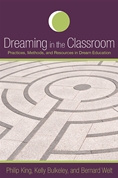 Phil King, Bernard Welt and I have written the newly released DREAMING IN THE CLASSROOM: PRACTICES, METHODS, AND RESOURCES IN DREAM EDUCATION, from the State University of New York Press. It has been a long time coming, and we are grateful to all the teachers we interviewed in the course of our research.
Phil King, Bernard Welt and I have written the newly released DREAMING IN THE CLASSROOM: PRACTICES, METHODS, AND RESOURCES IN DREAM EDUCATION, from the State University of New York Press. It has been a long time coming, and we are grateful to all the teachers we interviewed in the course of our research.
The back-cover endorsement comes from Ernest Hartmann, psychiatrist from Tufts University Medical School, who says, “This book will be extremely useful to educators at all levels. It can be considered the King James Bible of the field of dream education.”
The cover of the book is a photo taken by Justin Knight of the walking labyrinth in the back courtyard of Harvard Divinity School in Cambridge, Massachusetts. The creation of this labyrinth was inspired by a dream experienced by Laura Lamp, an administrator at HDS.
The first two chapters lay out the basic issues and principles that come into play any time a teacher brings the subject of dreams into the classroom. We especially emphasize dreaming as a resource in writing and composition classes, connecting dream experience with the development of fundamental academic skills.
Then come chapters on teaching dreams in specific disciplines at the college and graduate level: psychology, anthropology, philosophy and religious studies, general humanities, film studies, and psychotherapy and counseling. After that is a chapter on dream education in community/alternative settings, and a chapter on dream education with younger students in primary and secondary schools. We finish with reflections on “the future of dream education.”
It felt good last week to give a copy of the book to my youngest son’s 4th grade teacher, Jeff Grether at Windrush School, whose dream-and-writing assignment is mentioned on p. 182.
Now that I’ve got my own copy in hand, I feel the most valuable part of the book comes in the appendices, which offer an amazing variety of resources for teachers and aspiring teachers:
A. A Dreams Reading List
B. Course Syllabi
C. Establishing and Organizing Community Dream Groups
D. Outline for Short Presentations on Dream
E. Using the Dreambank
F. Preserving Narrative Meanings in Dream Content Analysis
G. Interdisciplinary Dream Course Template
H. Proposing a Course on Dreaming
I. Assessment of Educational Effectiveness in Dream Studies
J. Why I Teach Dreams in Freshman Composition (by Barbara Bishop)

Kudos to each of you. Hoping this book will encourage more teachers to educate our children about the importance and numerous potentials of dreams.
I’m so glad this is out! I’ve been looking forward to it since I heard about it at the IASD Conference in Chicago in 2009. Our world will be a different place when dream education is as universal as reading, writing, and math!
Thanks, Laurel. We do try to make a case that teaching students about dreams is a good way of promoting fundamental academic skills in writing, creativity, and critical thinking. A lot of social misperceptions get in the way, though, so the challenge is changing attitudes and dispelling anxieties.